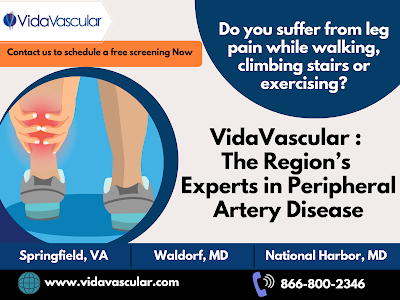Have you beendiagnosed with (PAD)?
Do you suffer from leg pain while walking, climbing stairs or exercising?
If you suspect that you suffer from PAD, the most important step is to search for a PAD specialist immediately! Blockages and pain are likely to worsen over time.

RISK FACTORS FOR PERIPHERAL ARTERY DISEASE
While PAD is a common condition, certain people are at a greater risk than others. Risk factors include:
-Smoking
-Diabetes
-Physical inactivity
-Chronic renal failure
-Obesity (body mass index over 30)
-High cholesterol and blood pressure
-Age and family history of heart disease
At VidaVascular, our doctors are board-certified vascular specialists with 20+ years of experience. We perform diagnostic ultrasound as well as the most advanced minimally invasive treatments for PAD such as angioplasty, stent placement, and atherectomy.
PAD can be painlessly diagnosed with a routine physical with our experienced medical staff. Noninvasive tests, such as ankle-brachial index (ABI) and doppler ultrasound, may also be performed to help to make a diagnosis.
If the ultrasound suggests that there is significant narrowing or blockage of the arteries of the legs, an angiogram may be recommended as the next diagnostic test. In this procedure, a thin catheter is inserted into the arteries of the legs. Contrast (xray dye) is injected, and pictures are taken of those blood vessels. The exact location of the narrowings or blockages can be precisely identified, and a treatment plan can be designed based upon those findings. At Vidavascular, we carefully formulate a treatment plan with the input of the patient and their family.
Treatment aims to
(1) reduce the pain associated with PAD and
(2) decrease the progression of atherosclerosis, thereby improving the ability to perform activities and preventing ulcers and loss of tissue.
If the abnormalities and symptoms are not severe, a medication may be prescribed first, to try to medically improve the circulation.
If the abnormalities are more severe, minimally invasive treatments to open up blocked arteries include:
Angioplasty, which involves using a small thin balloon at the end of a catheter to open up a narrowing.
Stent placement, which is a thin wire mesh tube that props open an artery to prevent it from closing again.
Atherectomy, which is done using a device like a “roto-rooter”, to clean out fatty plaque buildups.
Thrombolysis, which involves injection certain powerful “clot buster” medications to break up clot.
Sometimes, these minimally invasive treatments are not advised because the problem is too severe, and in that case, surgical bypass may be advised.
The physicians and staff at Vidavascular are among the most experienced in the entire region at performing these minimally invasive procedures, so that you can get back to your normal activities and enjoy life as soon as possible! Call us today to schedule a free screening for this and other conditions at a Vidavascular office in northern Virginia (convenient to Springfield, Fairfax, Alexandria, Arlington, Woodbridge) or Maryland (convenient to Waldorf, La Plata, Clinton).
Call VidaVascular Now ! (866) 800-2346 to schedule a consultation.
To schedule a free screening for this and other conditions at a VidaVascular office in northern Virginia (convenient to Springfield, Fairfax, Alexandria, Arlington, Woodbridge), Maryland (convenient to National Harbor, Oxon Hill, Waldorf, La Plata, and Clinton), and Washington DC.
Visit Us at :
https://www.vidavascular.com/arterial-disease/
https://www.yelp.com/biz/vidavascular-white-plains
https://www.yelp.com/biz/vidavascular-forest-heights
https://g.page/r/CUZgvWJp6-3GEAE



.png)
.png)
.png)
Comments
Post a Comment